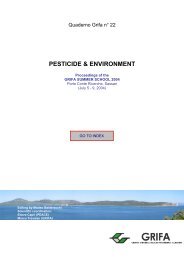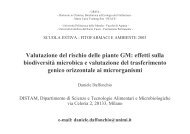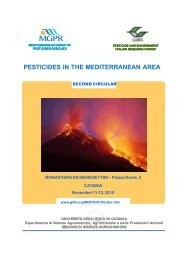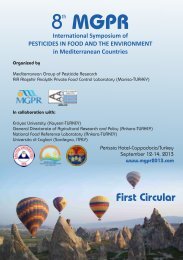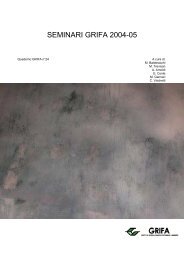International Congress BIOLOGICAL PRODUCTS - Gruppo di ...
International Congress BIOLOGICAL PRODUCTS - Gruppo di ...
International Congress BIOLOGICAL PRODUCTS - Gruppo di ...
You also want an ePaper? Increase the reach of your titles
YUMPU automatically turns print PDFs into web optimized ePapers that Google loves.
PROTECTION OF GRAPEVINE FROM POWDERY MILDEW BY USING NATURAL SUBSTANCES AND<br />
THE MICROBIAL ANTAGONIST AMPELOMYCES QUISQUALIS<br />
Agostino Santomauro (1) , Giuseppe Tauro (2) , Maurizio Sorrenti, Francesco Faretra (1)<br />
(1) Dipartimento Protezione delle Piante e Microbiologia Applicata, University of Bari<br />
(2) Centro <strong>di</strong> Ricerca e Sperimentazione in Agricoltura "Basile Caramia", Locorotondo (Bari)<br />
Powdery mildew, caused by Uncinula necator (Schw.) Burr., is one of the most common and severe <strong>di</strong>seases of<br />
grapevine, causing heavy yield losses wherever the crop is intensively grown. Many fungicides are available for its<br />
control. Recently, however, the rapid <strong>di</strong>ffusion of organic agriculture has stressed out the lack of solid experimental<br />
data on the effectiveness of natural substances and microbial antagonists that are potential alternatives to the use of<br />
chemicals.<br />
The present paper reports the results of field trials carried out in 1998, 2000 and 2001 in order to evaluate the<br />
effectiveness of natural substances and the mycoparasite Ampelomyces quisqualis Ces. for the control of grapevine<br />
powdery mildew.<br />
The statistical scheme of randomized blocks with four replications and plots of 8-10 plants was adopted in all<br />
trials. The first two sprays were always carried out at the beginning and at the end of blossoming. Afterwards,<br />
treatments were carried out at one-week intervals until véraison. The tested spray schedules are listed below.<br />
Tested compounds Formulates Rates Year of employment<br />
(g or ml/ha) 1998 2000 2001<br />
Ampelomyces quisqualis +<br />
AQ 10 (Bio Intrachem)<br />
50 + • • •<br />
Mineral oil<br />
Ultra Fine Oil (Bio Intrachem) 2000<br />
Ampelomyces quisqualis +<br />
AQ 10 (Bio Intrachem)<br />
50 +<br />
•<br />
Pinolene<br />
Vapor-Gard (Bio Intrachem) 2000<br />
So<strong>di</strong>um bicarbonate +<br />
RPH (Carlo Erba)<br />
5000 + • • •<br />
Mineral oil<br />
Ultra Fine Oil (Bio Intrachem) 2000<br />
So<strong>di</strong>um bicarbonate +<br />
RPH (Carlo Erba)<br />
5000 +<br />
•<br />
Pinolene<br />
Vapor-Gard (Bio Intrachem) 2000<br />
So<strong>di</strong>um bicarbonate RPH (Carlo Erba) 5000 •<br />
Foliar fertilizer Trym (Italpollina) 150 •<br />
Powder milk Vigor Latte (Mignini) 10000 •<br />
Mineral oil Ultra Fine Oil (Bio Intrachem) 10000 •<br />
Pinolene Nu - Film 17 (Chimiberg) 10000 •<br />
Pinolene Vapor-Gard (Bio Intrachem) 10000 • •<br />
Potassium salts of fatty acids MYX 403.2-050 (Mycogen) 10000 •<br />
Sulphur Zolfo WG (Bayer) 2500 •<br />
Sulphur Kumulus Tecno (Syngenta) 5000 •<br />
Symptom severity was assessed two to four times for each trial by observing 250-300 bunches per plot and<br />
counting infected berries. An empirical scale with 8 class of infection was used to calculate the following parameters:<br />
the percentage of infected organs (Tehon’s “prevalence”), the <strong>di</strong>sease severity (Tehon’s “destructiveness”) and its<br />
weighted average value (accor<strong>di</strong>ng to the McKinney Index). All data were submitted to variance analysis and mean<br />
values were separated by Duncan’s Multiple Range Test.<br />
During 1998 and 2000, powdery mildew infections interested 77% and 65% of bunches in untreated plots,<br />
respectively. The values of McKinney Index, however, were not very high, reaching 17% and 13%, respectively. Under<br />
these con<strong>di</strong>tions of me<strong>di</strong>um <strong>di</strong>sease pressure, all of the tested compounds showed to be effective against powdery<br />
mildew, decreasing significantly symptom severity on both berries and rachis, as compared to the untreated check. In<br />
particular, so<strong>di</strong>um bicarbonate (used either alone or in mixture with mineral oil) and pinolene showed the highest<br />
effectiveness, allowing reductions up to 90% of symptom severity. These results were substantially confirmed even<br />
under the higher <strong>di</strong>sease pressure occurred in the trial carried out in 2001. In that year, powdery mildew symptoms were<br />
observed on 88% of bunches in untreated plots, with a value of McKinney Index as high as 34%. Even under such<br />
con<strong>di</strong>tions, pinolene and so<strong>di</strong>um bicarbonate, used either alone or in mixture, allowed a significant reduction of the<br />
<strong>di</strong>sease. Moreover, very interesting results were obtained with powder milk that yielded the best control of the <strong>di</strong>sease.<br />
Repeated sprays with pinolene or potassium salts of fatty acids had some negative side effects on bunches, by<br />
removing waxes from the surface of berries and causing persistent bad smell. Repeated sprays with milk left visible<br />
residues, thus getting <strong>di</strong>rty bunches. Such effects represent a serious limitation for their usage on table grape, but should<br />
be negligible for wine grape.<br />
In conclusion, the tested natural substances and A. quisqualis showed an interesting, although not complete,<br />
effectiveness against grapevine powdery mildew. Yet, their exclusive usage in the protection of table grape seems can<br />
PDF creato con FinePrint pdfFactory versione <strong>di</strong>mostrativa http://www.secom.re.it/fineprint<br />
39



